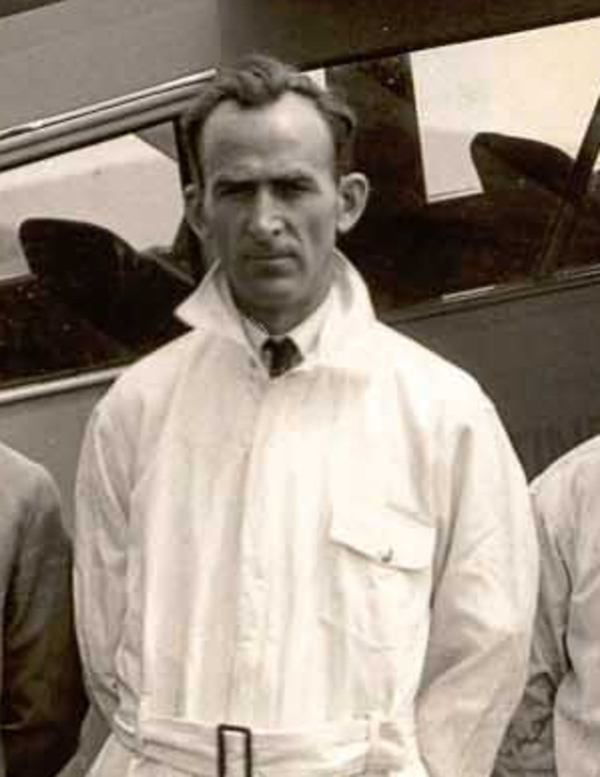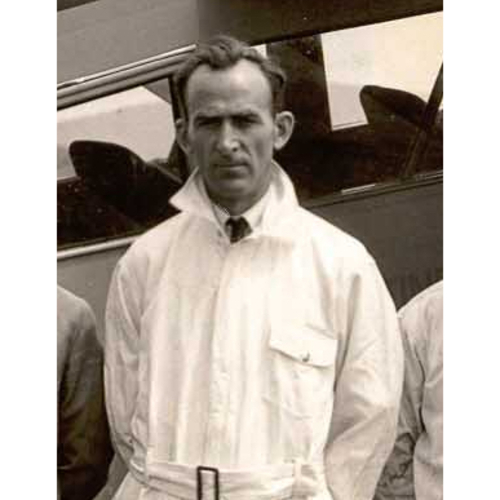
Source: Link
SAINT-MARTIN, JOSEPH-HERVÉ, mechanic, soldier, aviator, and businessman; b. 24 March 1894 in Saint-Gabriel-de-Brandon, Que., son of Désiré Saint-Martin, a farmer, and Marie-Louise Beausoleil; m. 2 Sept. 1927 Eileen Mary McEvoy in the parish of the Ascension of Our Lord in Westmount, Que.; they had no children; d. 5 March 1939 about ten miles from Lac-à-la-Croix (Métabetchouan–Lac-à-la-Croix), Que., and was buried nine days later in the parish of Notre-Dame, Montreal.
During his childhood, Joseph-Hervé Saint-Martin very likely lived in Saint-Gabriel-de-Brandon, where his family farmed, and then in Manville, R.I., where they lived off and on initially and on a more permanent basis starting in 1901. In Manville, Joseph-Hervé’s father (who had become a naturalized American citizen in 1893) found work, as did some of his children. His mother died there in 1905 and was buried in Saint-Gabriel-de-Brandon, where she had been married in 1889.
Saint-Martin studied at the Collège Laval in Saint-Vincent-de-Paul (Laval) from 1907 to 1910. He lived with his father in Montreal as of the following year at least. He acquired seven years of experience in auto mechanics and a solid knowledge of gasoline motors. From 1916 to 1918 he worked for the lawyer and former Liberal mla Henri-Benjamin Rainville.
On 12 Feb. 1918, near the end of the First World War, Saint-Martin joined the British military, signing up with the Royal Flying Corps. He was made a third-class air mechanic. On 9 July he was designated a flight cadet in the Royal Air Force. Discharged on 15 Feb. 1919, he later received a temporary commission as a 2nd lieutenant. He had accumulated some 400 hours of flying time during the war.
On his return to Canada in 1919 Saint-Martin went immediately into commercial aviation. This field was beginning to emerge at that time, and Saint-Martin contributed to the formation of the first aviation companies in Quebec. In 1920, when the Air Board issued its initial credentials, Saint-Martin was one of the first, if not the first, of the French Canadians who obtained a commercial pilot’s licence (no.23). He received it and his mechanic’s licence (no.20) probably on 27 May 1920 (some sources give 14 October as the date of his commercial pilot’s licence).
That year Robert Brian John Daville hired Saint-Martin as second pilot and mechanic of Canadian Aerial Services Limited, a new company established in Hampstead that specialized in aerobatic demonstrations such as simulated combat, races against automobiles, parachute jumps, movie stunts, and transportation for Santa Claus. A ten-minute ride in a little open-cockpit Avro 504K biplane cost ten dollars. On 29 August, because of a mechanical problem, Saint-Martin was forced to land on a residential street in Montreal’s Notre-Dame-de-Grâce ward (Côte-des-Neiges–Notre-Dame-de-Grâce district).
Working with the aviator William Roy Maxwell, Saint-Martin carried out the first winter flights in the James Bay region on 4 Feb. 1922 aboard the same biplane. The terms of the contract were to draw up, on behalf of an oil prospector, an inventory of potential sites for petroleum exploration in Ontario between Cochrane and Moose Factory. On 13 February Saint-Martin experienced a mechanical problem more than 60 miles north of Cochrane and had to return on foot.
During that period Saint-Martin helped Frederick Haskell (Tom) Wheeler to set up Laurentian Air Services (also known as Gray Rocks Air Service). Owned by the Wheeler family, the company transported wealthy vacationers from the hotel at the immense Gray Rocks resort in Saint-Jovite (Mont-Tremblant), Que., to fishing and hunting camps. Laurentian would diversify its activities and adopt the name Wheeler Airlines after the First World War.
In 1925 Saint-Martin flew an expedition from Montreal’s McGill University to the St Lawrence River in Ontario to study ice floes. He was a pioneer of the airmail service for Canadian Airways Limited, and on 5 May 1928 he inaugurated the Montreal–Toronto run, a link in the delivery of mail offloaded from transatlantic steamships at the pilot station in Pointe-au-Père (Rimouski), Que. [see Harry Stephen Quigley*].
In the summer of 1928 Saint-Martin became chief pilot of Continental Aero Corporation Limited. This flying school, located in the newly opened Aéroport de Saint-Hubert on the south shore of Montreal, acted as the eastern Canada representative for Travel Air aircraft. It was in this capacity that on 5 Aug. 1930, on the occasion of the dirigible R-100 being moored at Saint-Hubert, Saint-Martin set a spectacular record of 149 flights in a single day. Not long after this event, the Continental Aero Corporation fell victim to the Great Depression and ceased activities.
That year, at the request of the Quebec Liquor Commission, Saint-Martin carried out a series of patrols in the neighbourhood of Rimouski, with a view to detecting ships bringing contraband alcohol from the islands of Saint-Pierre and Miquelon.
During the 1930s, with the help of his wife, Eileen Mary, Saint-Martin operated his own air service from Saint-Félicien to Lac Saint-Jean. Taking advantage of the mining boom in the Chibougamau region, the company, which was called St-Martin Air Transport, attracted a loyal clientele of fishermen and hunters. It owned a big Junkers W33 transport plane and a WACO-type biplane with an enclosed cabin. For the accommodation of their clients, the couple also owned a luxurious camp at Lac-à-la-Croix, about 93 miles north of Saint-Félicien.
On 5 March 1939 Saint-Martin was killed on board the biplane, a few minutes after taking off from Lac-à-la-Croix en route to Saint-Félicien. With him were his close friend, the mechanic and apprentice pilot Oscar Therrien, and John C. Stadler, an employee of the Canadian Broadcasting Corporation. All three died in the crash, the cause of which could not be explained at the time. On the day of the flight the weather forecast was glorious and the plane had no known mechanical problems. A pilot of Saint-Martin’s calibre normally would have had no difficulty in making a forced landing in the region.
Saint-Martin, whose prowess was acknowledged by his peers, had only one phobia: boarding a plane in which he would not be at the controls. He had built his career on the principle never to do so. Shortly before his death, however, Saint-Martin had taken up filming as a new hobby and was in the habit of bringing along his 8 mm camera wherever he went. The investigators found the broken apparatus in the remains of the aircraft and examined its contents, which enabled them to clarify the circumstances surrounding the accident. They discovered that the three men had come upon a herd of stampeding caribou and filmed them at such a close range that the bristling hairs on their backs were distinctly visible. Excited by the idea of capturing extraordinary footage, Saint-Martin had handed over the controls to Therrien. As they approached, Therrien tipped the plane sideways so that the cameraman would have a better view. Saint-Martin was too preoccupied to realize that his apprentice pilot, through lack of experience, was trying to hold the plane in an impossible position. The last frame showed the plane diving suddenly towards the ground. Ironically, Saint-Martin lost his life on one of the rare occasions – indeed, perhaps the only one – when he was aboard an aircraft without being at the controls.
Acknowledged as one of the best pilots in the country, Joseph-Hervé Saint-Martin made his mark as a pioneer of Canadian aviation and airmail delivery, an entrepreneur, and a bush pilot. He served in the First World War and achieved remarkable feats. On 21 Oct. 2002, the Fondation Aérovision Quebec made him a member of its Panthéon de l’Air et de l’Espace du Québec.
BANQ-CAM, CE605-S23, 25 juin 1889, 20 oct. 1891, 25 mars 1894, 19 mai 1898, 24 juill. 1905. Church of Jesus Christ of Latter-day Saints, “Rhode Island deaths and burials, 1802–1950”; “Rhode Island state census, 1905”; “United States, New England petitions for naturalization index, 1791–1906”: www.familysearch.org (consulted 11 Aug. 2016). FD, Ascension of Our Lord (Westmount, Que.), 2 Sept. 1927; Notre-Dame (Montréal), 14 mars 1939. LAC, Census returns for the 1911 Canadian census, Que., dist. Hochelaga (160), subdist. St-Henri (28): 41; R233-37-6, Que., dist. Berthier (142), subdist. St-Gabriel-de-Brandon (H): 2. NA, AIR 76/336/130; AIR 79/1547. Le Devoir, 30 août 1920; 9, 11 mars 1939. La Patrie, 9, 10, 11, 13 mars 1939. La Presse, 30 août 1920, 9 mars 1939. “Continental Aero Corporation plan: large expansion: increasing original capitalization of $50,000 to $500,000 with object of improving equipment and service,” Canadian Aviation (Toronto), 3, March 1930: 13, 37. R. B. [J.] Daville, “Canadian Aerial Services Ltd.,” Canadian Aviation Hist. Soc., Journal (Willowdale, Ont.), 9 (1971): 53–60. J. R. Ellis, “The Canadian civil aircraft register: G-CANM to G-CARU,” Canadian Aviation Hist. Soc., Journal, 13 (1975): 25–30; “The Canadian civil aircraft register: G-CARW to G-CAVX,” Canadian Aviation Hist. Soc., Journal, 13: 85–94. Stuart Graham, “Hervé St Martin: leaving the evidence” (typescript, n.p., n.d.; copy held at the DCB). Raoul Lapointe, Rodolphe Pagé, pionnier de l’aviation au Québec: pilote de brousse et pilote commercial, père de l’aviation au Saguenay, peintre (Montréal, 1972). London Gazette, 13 June 1919. K. M. Molson, The first 500 Canadian civil pilots (Toronto, 1983). Michel Pratt, Les dirigeables R-100 et R-101: le succès du voyage du R-100 au Québec et la tragédie du R-101 en France ([Montréal], 2003). Pierre Thiffault, Au temps des premières ailes: petite histoire aérienne du Québec (Laval, Québec, 2004); “The life and death of Hervé St-Martin: pioneer Québec pilot,” Canadian Aviation Hist. Soc., Journal, 43 (2005): 110–17. “Training Canada’s future commercial pilots: Continental Aero Corporation report: progress under instruction of Captain J. H. St. Martin,” Canadian Aviation, 2, March 1929: 32. W. (Babe) Woollett, Have a banana! ([North Battleford, Sask.], 1989).
Cite This Article
Pierre Thiffault, “SAINT-MARTIN, JOSEPH-HERVÉ,” in Dictionary of Canadian Biography, vol. 16, University of Toronto/Université Laval, 2003–, accessed December 30, 2025, https://www.biographi.ca/en/bio/saint_martin_joseph_herve_16E.html.
The citation above shows the format for footnotes and endnotes according to the Chicago manual of style (16th edition). Information to be used in other citation formats:
| Permalink: | https://www.biographi.ca/en/bio/saint_martin_joseph_herve_16E.html |
| Author of Article: | Pierre Thiffault |
| Title of Article: | SAINT-MARTIN, JOSEPH-HERVÉ |
| Publication Name: | Dictionary of Canadian Biography, vol. 16 |
| Publisher: | University of Toronto/Université Laval |
| Year of publication: | 2021 |
| Year of revision: | 2021 |
| Access Date: | December 30, 2025 |



